unit5第一课时(1)
- 格式:ppt
- 大小:1.14 MB
- 文档页数:22

【新思路】第五单元第一课时教案单元总述单元要点分析本单元Let’s talk部分是围绕“职业”这一话题展开的,A部分由Sarah询问Oliver父母的职业,引出句子:What does he do? He’s a businessman.B部分则通过Xiao Yu与Mike 谈论他舅舅的职业,引出在哪儿工作和如何上班的英文表达:Where does he work?He works at sea. How does he go to work? He goes to work by bike.Let’s learn部分则是在四年级上册学习了职业类单词doctor、cook、driver、farmer、nurse 的基础上继续学习:factory,worker,postman,businessman,police office,fisherman scientist,pilot,coach。
Tips for pronunciation 部分,要求学生通过听音、跟读的方式理解句子中的停顿现象,为良好的语音、语调的形成打下坚实的基础。
教材还设计了许多活动,如:Listen,match and say,让学生通过昕音连线对话的方式,来谈谈家庭成员的职业;Write and discuss让学生通过讨论的形式来了解各种职业的工作场所。
这些丰富有趣的活动,来源于学生的生活实际,使他们能在轻松愉悦的环境中体会学习语言、运用语言的乐趣。
单元教学目标能力目标1.学习询问并回答他人职业的一组问答句:What does he/she do? He’s/She’s a…,;能用问答句Where does he/she work? He/She works….How does he/she go to work? He/She goes to work by…来描述各种职业人的工作场所及上班的交通方式。
2.能掌握四会单词或词组:factory,worker,postman,businessman,policeofficer,fisherman,scientist, pilot, coach。
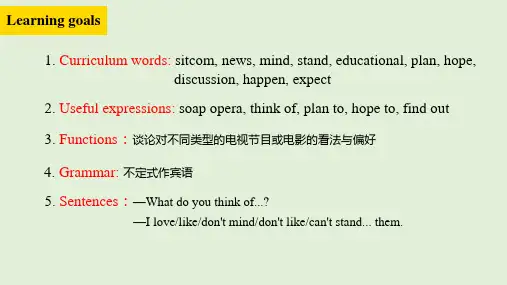
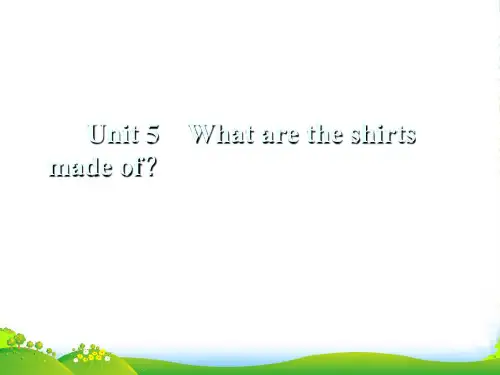

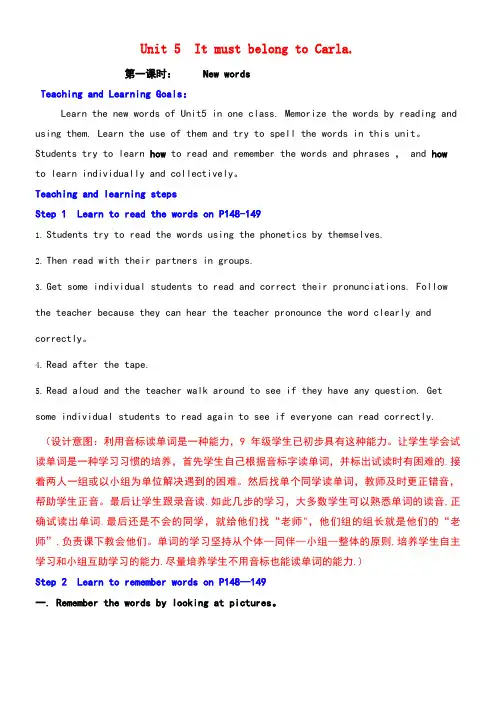
Unit 5 It must belong to Carla.第一课时: New wordsTeaching and Learning Goals:Learn the new words of Unit5 in one class. Memorize the words by reading and using them. Learn the use of them and try to spell the words in this unit。
Students try to learn how to read and remember the words and phrases , and howto learn individually and collectively。
Teaching and learning stepsStep 1 Learn to read the words on P148-1491.Students try to read the words using the phonetics by themselves.2.Then read with their partners in groups.3.Get some individual students to read and correct their pronunciations. Follow the teacher because they can hear the teacher pronounce the word clearly and correctly。
4.Read after the tape.5.Read aloud and the teacher walk around to see if they have any question. Get some individual students to read again to see if everyone can read correctly. (设计意图:利用音标读单词是一种能力,9年级学生已初步具有这种能力。

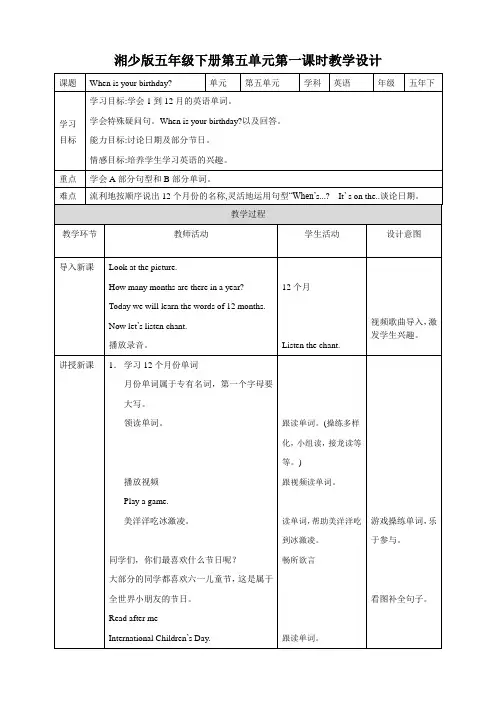
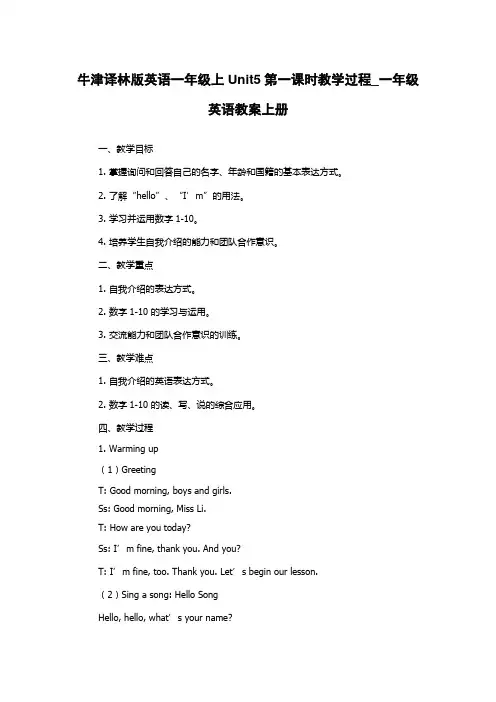
牛津译林版英语一年级上Unit5第一课时教学过程_一年级英语教案上册一、教学目标1. 掌握询问和回答自己的名字、年龄和国籍的基本表达方式。
2. 了解“hello”、“I’m”的用法。
3. 学习并运用数字1-10。
4. 培养学生自我介绍的能力和团队合作意识。
二、教学重点1. 自我介绍的表达方式。
2. 数字1-10 的学习与运用。
3. 交流能力和团队合作意识的训练。
三、教学难点1. 自我介绍的英语表达方式。
2. 数字1-10 的读、写、说的综合应用。
四、教学过程1. Warming up(1)GreetingT: Good morning, boys and girls.Ss: Good morning, Miss Li.T: How are you today?Ss: I’m fine, thank you. And you?T: I’m fine, too. Thank you. Let’s begin our lesson.(2)Sing a song: Hello SongHello, hello, what’s your name?Hello, hello, what’s your name?My name’s _____, my name’s_____.Hello, hello, what’s your name?(3)Game: Simon saysT: Let’s play a game. This game is called “Simon says”. If I say “Simon says, touch your nose”, everyone needs to touch their nose. If I don’t say “Simon says” but I still tell you to touch your nose, don’t do it. OK?2. Presentation(1)Show a picture of a Chinese student or a foreigner student.T: Do you know who is he/she?S1: He/She is a student.S2: He/She is a Chinese student/ a foreigner student.T: Right. And do you know his/her name?S3: No.T: Let’s ask him/her.T: What’s your name?A:My name is……T: Hello Nick, I’m Miss Li. Nice to meet you.A: Nice to meet you too.(2)Show pictures of different national flags.T: Do you know which country this flag is from?S4: This flag is from……T: Very good. Do you know the name of this country’s people?S5: Yes. They are……3. Getting started and Let’s learn(1) Present the conversation on page 28.T: Now, let’s look at page 28. This is Daniel. He is a student. Look, he wants to make friends with some new students. Let’s see what he says.T: Boys and girls, please listen to me and read after me.T+ Ss: Hello. I’m Daniel.T: Hi, Daniel. I’m Lily. Nice to meet you.T: What’s your name?T+ Ss: My name is ……(2) Introduce the new words and sentences.T: Do you know how to say “1” in English?Ss: Yes. It’s “one”.T: How about “2”?Ss: It’s “two”.T: And “10”?Ss: It’s “ten”.(3) Read and play a game “Slap the card”.(将数字图片和数字英文卡片混在一起,让学生抢答,翻牌说英文或看英文说数字。
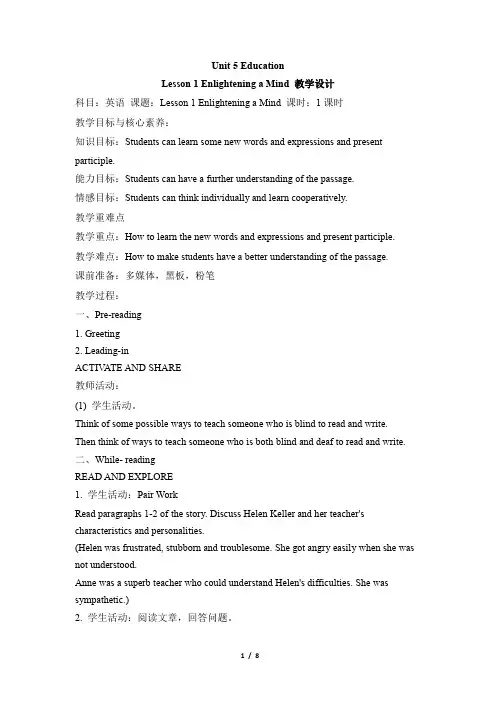
Unit 5 EducationLesson 1 Enlightening a Mind 教学设计科目:英语课题:Lesson 1 Enlightening a Mind 课时:1课时教学目标与核心素养:知识目标:Students can learn some new words and expressions and present participle.能力目标:Students can have a further understanding of the passage.情感目标:Students can think individually and learn cooperatively.教学重难点教学重点:How to learn the new words and expressions and present participle.教学难点:How to make students have a better understanding of the passage.课前准备:多媒体,黑板,粉笔教学过程:一、Pre-reading1. Greeting2. Leading-inACTIV ATE AND SHARE教师活动:(1) 学生活动。
Think of some possible ways to teach someone who is blind to read and write. Then think of ways to teach someone who is both blind and deaf to read and write.二、While- readingREAD AND EXPLORE1. 学生活动:Pair WorkRead paragraphs 1-2 of the story. Discuss Helen Keller and her teacher's characteristics and personalities.(Helen was frustrated, stubborn and troublesome. She got angry easily when she was not understood.Anne was a superb teacher who could understand Helen's difficulties. She was sympathetic.)2. 学生活动:阅读文章,回答问题。

第一课时一、课时内容敎科书第48页:A. Let’s try Let’s talk二、课时分析本课时是义务敎育灵通版(pep)小学英语敎科书五年级上册的第五单元第一课时,围绕“What is in the room?”这个话题展开内容,为大家展示了There is…这个句型的用法。
包括Let’s try和Let’s talk两个板块。
本课时是本单元第一课时,是整个单元敎学的总基石,对本单元余下的课程学习起着举足轻重的作用, 只有牢固地掌握本课时的学习内容才能为本单元其它课时的学习做好铺垫,打好基础。
Let’s try是简单的听力训练,是为Let’s talk部分做铺垫的,以Sarah 和Mike 参观张鹏的卧室为背景,其设计目的是为学生们展示出本课时、同时也是本单元的核心句型:There is …,让学生对这一新句型形成初步印象。
这一部分的听力材料没有涉及本单元的新单词,难度相对而言不太高。
学生只要听出关键的句子和词汇,然后在课本上勾选出恰当的图片即可。
Let’s talk是Let’s try 的一个变形、延伸练习,在Let’s try的基础上,该部分的背景同样是在参观张鹏的卧室时,Sarah 、Mike 和张鹏之间的对话,并且在对话的左侧给出了一张张鹏卧室的图片,方便学生以图文结合的方式进行学习。
本部分的重要句型有:There is a big bed.这里有一张大床。
There is a nice photo, too.这儿也有一张好看的相片。
敎材将There is …句型放在一个完整的对话情境中,方便学生根据当时的语言环境进一步感知该句型的语义,并学习如何正确地使用该句型。
与此同时,Let’s talk中出现了本单元的一个新单词photo,敎师可以借助该部分的图画,引导学生对photo一词进行初步地认识。
对话之后,课本上另外给出一张图片,要求学生能够模仿上面对话中的句式,对这张图片进行基本地描述,进行简单的对话。
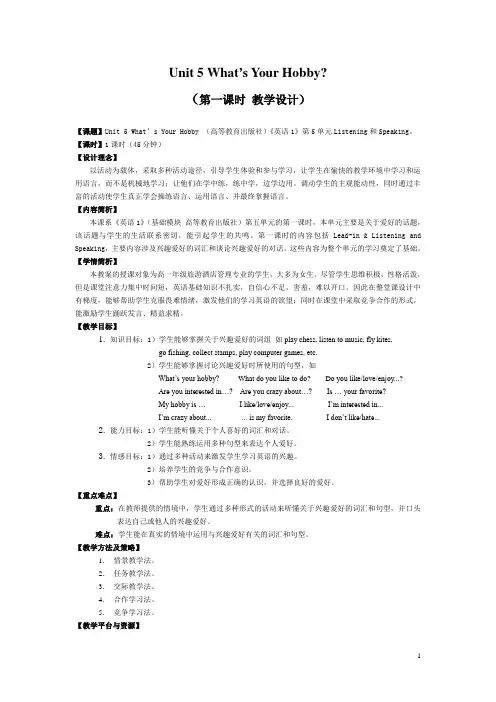
Unit 5 What’s Your Hobby?(第一课时教学设计)【课题】Unit 5 What’s Your Hobby (高等教育出版社)《英语1》第5单元Listening和Speaking。
【课时】1课时(45分钟)【设计理念】以活动为载体,采取多种活动途径,引导学生体验和参与学习,让学生在愉快的教学环境中学习和运用语言,而不是机械地学习;让他们在学中练,练中学,边学边用。
调动学生的主观能动性,同时通过丰富的活动使学生真正学会操练语言、运用语言、并最终掌握语言。
【内容简析】本课系《英语1》(基础模块高等教育出版社)第五单元的第一课时,本单元主要是关于爱好的话题,该话题与学生的生活联系密切,能引起学生的共鸣。
第一课时的内容包括Lead-in & Listening and Speaking,主要内容涉及兴趣爱好的词汇和谈论兴趣爱好的对话。
这些内容为整个单元的学习奠定了基础。
【学情简析】本教案的授课对象为高一年级旅游酒店管理专业的学生,大多为女生。
尽管学生思维积极,性格活泼,但是课堂注意力集中时间短,英语基础知识不扎实,自信心不足,害羞,难以开口。
因此在整堂课设计中有梯度,能够帮助学生克服畏难情绪,激发他们的学习英语的欲望;同时在课堂中采取竞争合作的形式,能激励学生踊跃发言、精益求精。
【教学目标】1.知识目标:1)学生能够掌握关于兴趣爱好的词组如play chess, listen to music, fly kites,go fishing, collect stamps, play computer games, etc.2)学生能够掌握讨论兴趣爱好时所使用的句型,如What’s your hobby? What do you like to do? Do you like/love/enjoy...?Are you interested in…? Are you crazy about…?Is … your favorite?My hobby is … I like/love/enjoy... I’m interested in...I’m crazy about... ... is my favorite. I don’t like/hate...2.能力目标:1)学生能听懂关于个人喜好的词汇和对话。
《Unit 5》(Lesson 1)教学设计T: Practice in pair. 两人一组,来练一练吧!T: 小朋友们,你们会读了吗?可以课后读练习哦。
T: 好了,那么,赶紧将你所学的知识运用到生活中去吧。
Ok, see you next time, goodbye. Boys and girls, saygoodbye to your friends.同学们,来和电视机前的小朋友说再见吧。
根据学生做练习的情况,帮助学生查漏补缺学练结合,巩固新知练一练 1.同学们,刚刚学完了课文,大家能分角色说一说吗?2.跟着Wu Yifan, ChenJie和John来一起练一练。
Unit 5 Let's eat!第一课时教学目标1. 能听、说、认读单词juice,egg,bread。
2. 能用英文介绍这些食物。
3. 会用I'd like…表达自己想要的食物。
教学重点1. 掌握句型I'd like…, please.Here you are.Have some juice/bread/eggs…2. 在创设的情景中,能用I'd like…, please. Have some…来表达喜好和询问。
教学难点运用所学的句型I'd like some…, please.完成Let's play部分的活动。
教学准备1. 装有鸡蛋、果汁和面包的盒子。
2. 教学挂图、配套的教学课件。
3. 母亲、迈克的头饰。
4. 相关的食物模型。
教学方法1. 角色表演教学法:教师利用实物,如一杯果汁、几片面包、鸡蛋等和学生分角色表演Let's talk中的小对话。
2. 一问一答法:学生就自己准备的食物和饮料的图片同桌之间进行对话练习:What would you like?I'd like some bread.在一问一答中不但巩固了单词,而且提高了学生的口语表达能力。
教学过程Step 1:arm-up1. 教师播放上单元歌曲Old MacDonald,师生跟唱,并跟着节奏打拍子。
Unit 5 Can You Tell Me the Way to theSupermarket?陕西旅游版 五年级上册Part A Read and draw& Let's learnAsk and answerT: Where is your home? S1: It’s near a school.S2: It’s behind a park.S3: It’s ...Play a gameI am a fairy. Can you find me?S1: Are you in the tree? S2: Are you...①supermarket /ˈsuːpəˌmɑːkɪt/(名词) 超市②beside /bɪˈsaɪd/(介词) 在……旁边③behind /bɪˈhaɪnd/(介词) 在……后面④between /bɪˈtwiːn/(介词) 在……之间⑤Children’s Park 儿童公园⑥take a bus乘公共汽车⑦get off the bus 下公共汽车House?Take a bus?No.Yes.Guessing gamesRead and draw答案:(提示)在书桌上画一本书。
在餐桌下面画一条狗。
在沙发上画一只猫。
在窗户旁边画一张床。
Let’s learnLet’s learn①supermarket /ˈsuːpəˌmɑːkɪt/(名词) 超市【单词巧记】super(超级的) +market (市场) = supermarket(超市)【复数形式】supermarkets【短语】in the supermarket 在超市【近义词】shop 商店 store商店重点词汇重点词汇②beside /bɪˈsaɪd/(介词) 在……旁边【单词巧记】be + side(边) = beside(在……旁边)【例句】I sit beside Lily. 我坐在莉莉旁边。
Unit 5Why do you like pandas?单元目标第一课时Section A (1a-2d) 课时目标自主学习根据句意及音标提示写出单词及其汉语意思。
1.The pandas /'əs/ in the zoo are so cute. 熊猫2.There's a big elephant /'elɪfənt/ under the tree. 大象3.Do you like animals /'ɪmlz/? 动物4.You are really lazy /'leɪzɪ/. Get up now! 懒惰的5.I have a smart /smaː(r)t/ dog, and it is cute. 聪明的6.How beautiful /'bjuːtɪfl/ the flower is! 美丽的7.Your father is sleeping /'sliːpɪŋ/. 睡觉教学过程环节1新课导入教师向学生展示四张与动物有关的图片,然后提出下列问题,学生思考并回答。
T:What is this in the first picture?Ss:It's a panda!T:Do you like pandas?S1:Yes, I do.T:Why do you like pandas?S2:Because they are cute and smart.T:Do you like elephants/tigers/giraffes?...设计意图:通过图片吸引学生的眼球,让学生将注意力转移到课堂上;通过询问学生喜爱的动物及其原因,达到活跃课堂氛围的效果,从而自然地进入本课时的教学。
环节2学习1a-1c1.教师先让学生朗读本课时的生词,并理解词义。
2.让学生仔细观察1a中的图片,并和同桌讨论图中有哪些动物,然后将图片上的动物与左边的动物名称匹配起来。